For “Travel Tuesday”:
Let’s visit Lake Texana, TX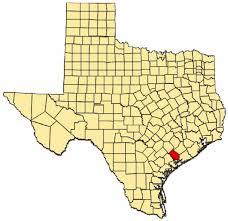
“Lake Texana, in east central Jackson County, was constructed by the United States Bureau of Reclamation and in 1988 was the only major reservoir project in the Lavaca River basin. The lake is a program of the Lavaca-Navidad River Authority and supplies municipal and industrial water to numerous communities within the region.”
“The lake was formed by Palmetto Bend Dam, an enterprise approved by Congress in 1968 and completed in 1979. The dam is a rolled earth-filled structure eight miles in length with a maximum crest elevation of fifty-five feet. The project derives its name from the dwarf palmetto (Sabal minor), a common bottomland plant in the area. The lake is named after the town of Texana, established in 1832 near the junction of the Navidad and Lavaca rivers.
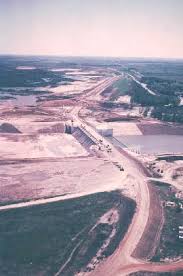
Aerial view of the spillway and maximum dam section facing east. Note the river diversion on the far side of the concrete spillway section. Photo April 8, 1980.
Palmetto Bend Dam backs up water from the Navidad River for a distance of eighteen miles, forming a reservoir with about 11,000 surface acres, 125 miles of shoreline, and a storage of 170,000 acre-feet. The land along the banks of Lake Texana supports a wide variety of plant species, including live oak, post oak, and fewer pecan, water oak, American elm, cedar elm, Texas sugarberry, red mulberry, and hawthorn trees.”
History:
“Like all Reclamation facilities, Palmetto Bend Dam was the result of western settlement and development of the West. Before this occurred the area was the home of the Karankawas. These native people were a hunting and gathering society that found their livelihood from both the land and sea along the coastal plain.
Nearby Matagorda and Lavaca bays and the Lavaca and Navidad river valleys provided nomadic family-based bands of people with much of their food. They were patrilineal and the size of their bands varied with economic prosperity. The Karankawas are remembered today in the Rockport pottery of the Texas gulf and their use of asphaltum to decorate pottery.
The first known White settlement occurred in 1685 when the French Explorer LaSalle established the ill-fated Fort St. Louis on Lavaca Bay. Several missions and presidios were established in the area between 1718 and 1795. The Spanish constructed them to prevent any further French landings while furthering their own interests. By 1821, three hundred years after white men set foot in Texas, only three outposts remained between the Sabine and Rio Grande Rivers. San Antonio and Goliad in the San Antionio River Basin and Nacodoches in east Texas. The white population of Texas was not more than 7,000 of which most were Spanish.
The first permanent Anglo-American settlement in the area was the result of Mexican land grants to Stephen F. Austin and Green De Witt. Jackson County was settled in 1831, three years before the town of Texana was established. Texana became the Jackson county seat from 1835 to 1883 and was located near the Palmetto Bend Reservoir site. Also nearby was Camp Independence.
This camp served as a bivouac for a portion of the First Texas Army under the command of General Felix Huston and later General Albert Sidney Johnston. Camp Independence was occupied for six months until the army was disbanded by order of President Sam Huston in May, 1837. The last days of the Texas Republic saw the beginning of German settlement in south Texas. During early statehood Texana emerged as the county's chief town. As early as 1840 a weekly steamboat ran from Texana to the pass of Matagorda Bay.
In 1840 Texana incorporated as a municipality. By 1880 the town had acquired regular steamboat service, mail and stage routes, a booming business section, and its own newspaper, the Clarion. As late as 1882 Texana was a thriving port with as many as twenty ships docking each week.
Transportation was an important factor in the early development of the coastal plains. The first stage line came in 1861. However, conflicts with Mexico and civil and Indian strife inhibited further settlement until after the reconstruction period following the Civil War. The upsurge of railroad construction in the 1880's brought renewed settlement and stability to the area, but Texana was bypassed by the New York, Texas, and Mexican Railway Company in 1883. Shortly thereafter county voters elected to make Edna, Texas the county seat, and by 1884 Texana was a virtual ghost town. By 1884 the township was virtually deserted and evidence of the existence of Texana rapidly vanished.”
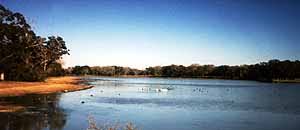 “Palmetto Bend Dam was begun in 1968 and completed in 1980 at a cost of approximately $92 million. The resulting reservoir covered the ghost town of Texana, which had been founded in 1832 near the junction of the Navidad and Lavaca rivers.”
“Palmetto Bend Dam was begun in 1968 and completed in 1980 at a cost of approximately $92 million. The resulting reservoir covered the ghost town of Texana, which had been founded in 1832 near the junction of the Navidad and Lavaca rivers.”
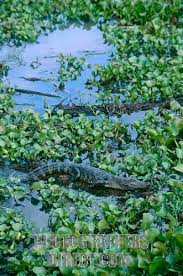 Fish and plant populations
Fish and plant populations
“Lake Texana has been stocked with fish intended to encourage recreational fishing. Fish present in Lake Texana include catfish, largemouth bass, white crappie, white bass, hybrid striped bass, and sunfish. A variety of native plant species thrive in the lake, including water hyacinth, coontail, spikerush, cattail, pondweed, bull's tongue, pickerel weed, and duckweed. Two exotic, invasive species exist in the lake: hydrilla and giant salvinia. The giant salvinia is presently limited to the Sandy Creek arm of the reservoir.”
________
LAKE TEXANA STATE PARK
“Soon Lake Texana State Park won't be a state park. The state says it can no longer afford the lease and management will revert to a local river authority. New management says they'll make improvements and reduce day use fees.”
“Lake Texana State Park is located in Jackson County, halfway between Houston and Corpus Christi on Lake Texana.
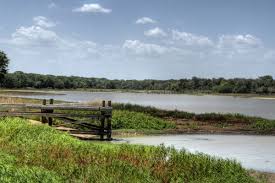 Lake Texana State Park is 6½ miles east of Edna in central Jackson County. The park consists of 575 acres of coastal prairie and oak woodlands and is operated under a fifty-year lease from the Lavaca-Navidad River Authority and Water and Power Resources Service. The main entrance to the park is on State Highway 111.
Lake Texana State Park is 6½ miles east of Edna in central Jackson County. The park consists of 575 acres of coastal prairie and oak woodlands and is operated under a fifty-year lease from the Lavaca-Navidad River Authority and Water and Power Resources Service. The main entrance to the park is on State Highway 111.
The park provides opportunities for camping, fishing, swimming, canoeing, boating, and hiking. It also offers more leisurely pleasures such as picnicking and unstructured nature study. The area houses a wide variety of trees, including live oak, post oak, pecan, water oak, American elm, cedar elm, Texas sugarberry, red mulberry, and hawthorn.
The shrubs and vines include yaupon, American beautyberry, greenbriar, and mustang grapes. A double ramp provides ready excess to the lake. Anglers may cast from the banks, boats, a jetty, a pier handy to picnic areas, or either of two lighted fishing piers located near the overnight-use areas.”



"The park is located in the flat Gulf Coast Vegetational Region, but the majority of the park land consists of mixed oak and pecan woodlands associated with the Navidad River. White-tailed deer, squirrels, rabbits, armadillos, and raccoons are numerous. Occasional sightings of bobcat and turkey. Alligators are found in the park coves and should not be approached or fed. Popular fish include crappie, catfish, and white bass. "
“The majority of the park consists of mixed oak and pecan woodlands. White-tailed deer, squirrels, rabbits, nine-banded Armadillos, and raccoons are numerous. There are occasional bobcat and wild turkey sightings. American alligators are also found in the park.”

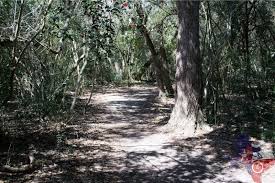
“Lake Texana State Park is a great spot for swimming, boating, fishing and wildlife viewing - including deer and alligators. The park features a Nature Center and offers interpretive programs throughout the year.”
“Lake Texana State Park is closed, pending lease termination and park transfer to the Lavaca Navidad River Authority (LNRA). It is currently anticipated that the park will re-open on Labor Day Weekend (August 31, 2012) and will be operated by the LNRA. For more details, please contact LNRA at 361-782-5456.”
___________
On This Day:
Russians settle Alaska, Aug 14, 1784:
On Kodiak Island, Grigory Shelikhov, a Russian fur trader, founds Three Saints Bay, the first permanent Russian settlement in Alaska.
The European discovery of Alaska came in 1741, when a Russian expedition led by Danish navigator Vitus Bering sighted the Alaskan mainland. Russian hunters were soon making incursions into Alaska, and the native Aleut population suffered greatly after being exposed to foreign diseases. The Three Saints Bay colony was founded on Kodiak Island in 1784, and Shelikhov lived there for two years with his wife and 200 men. From Three Saints Bay, the Alaskan mainland was explored, and other fur-trade centers were established. In 1786, Shelikhov returned to Russia and in 1790 dispatched Aleksandr Baranov to manage his affairs in Alaska.
Baranov established the Russian American Company and in 1799 was granted a monopoly over Alaska. Baranov extended the Russian trade far down the west coast of North America and in 1812, after several unsuccessful attempts, founded a settlement in Northern California near Bodega Bay. British and American trading vessels soon disputed Russia's claims to the northwest coast of America, and the Russians retreated north to the present southern border of Alaska. Russian interests in Alaska gradually declined, and after the Crimean War in the 1850s, a nearly bankrupt Russia sought to dispose of the territory altogether.
The czarist government first approached the United States about selling the territory during the administration of President James Buchanan, but negotiations were stalled by the outbreak of the American Civil War. After the war, Secretary of State William H. Seward, a supporter of territorial expansion, was eager to acquire the tremendous landmass of Alaska, one-fifth the size of the rest of the United States. On March 30, 1867, Secretary of State William H. Seward signed a treaty with Russia for the purchase of Alaska for $7.2 million. Despite the bargain price of roughly two cents an acre, the Alaskan purchase was ridiculed in Congress and in the press as "Seward's folly," "Seward's icebox," and President Andrew Johnson's "polar bear garden." In April 1867, the Senate ratified the treaty by a margin of just one vote.
Despite a slow start in settlement by Americans from the continental United States, the discovery of gold in 1898 brought a rapid influx of people to the territory. Alaska, rich in natural resources, has been contributing to American prosperity ever since. On January 3, 1959, President Dwight D. Eisenhower signed a proclamation admitting the territory of Alaska into the Union as the 49th state.”
__________
Yesterday:
Misty and I went down to Jay’s to get their old Sunday newspaper. He hadn’t called me, even though he had said that he wanted to work, but when I got there he said he was sick. He said it was from eating a pot pie, but he won’t use a thermometer in the food that he is cooking or reheating, so he deserves what he gets. I don’t know how someone his age can be sick so much, I don’t get sick, and I am a lot older than he is, but I am not an alcoholic either.
Also, I sneaked a bag of used puppy newspapers in Jay’s garbage, as their trash man is used to them having a massive amount of garbage. I just don't know how two people can have so much. They do have a lot of water bottles, gallon milk jugs and beer cans in theirs though.
My daughter and I had been discussing how we keep passwords scribbled on a card that could get lost. I made a legible list of mine and put it in the safe. Some more junk mail, with my name on it was shredded, so that tidied up my desk. I am on the Do Not Mail List, but stuff still gets through.
With the puppies having a litter box now, their puppy pen does stay cleaner, so hopefully, with the neighbors help, I can keep up with the demand for the newspaper for it. I am very proud of the pups when they are loose plating in the Grooming Room if they go back in their pen to their box to do their thing. Hopefully that will make it easier for their new ‘parents’. Their former Dad came to visit them, and to bring some newspaper. He was impressed with their growth, health, and my set-up for them, but they didn’t seem to remember him.
The smallest pup is still just under 2 lb, so they can’t have their spay and neuter surgeries yet, but Kenya is supposed to come and give them their second batch of shots today.
















No comments:
Post a Comment